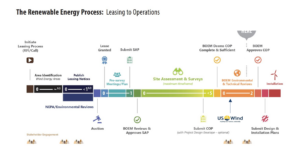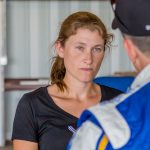
BERLIN– As the public comment period related to offshore wind remains open this month, US Wind highlighted local turbine plans at an Ocean Pines meeting last week.
Dave Wilson, Maryland development manager for US Wind, made an informational presentation to the Ocean Pines Association’s board of directors Saturday. Wilson outlined the company’s plans and highlighted efforts being made to ensure wildlife isn’t impacted negatively by the project.
The public comment period regarding a draft environmental impact statement on the US Wind project currently being conducted by the Bureau of Ocean Energy Management (BOEM) remains open for the next few weeks.
“You can comment until Nov 20 online,” Wilson said. “We encourage folks to do that we always want to learn how to make the project better.”
As the wind energy project planned off the coast of Ocean City moves closer to construction, Wilson approached the board last Saturday to provide an overview of the project. While there are currently only seven turbines in the water off the entire East Coast, 15 projects are in the permitting phase, according to Wilson. The Biden administration has a goal of deploying 30,000 megawatts of offshore wind by 2030.
US Wind leased turbine space from BOEM after more than five years was spent identifying the right location, Wilson said.
“It’s kind of in a sweet spot,” he said, adding that it shouldn’t impact commercial traffic, recreational boaters or wildlife.
While US Wind has offshore wind credits, Wilson said it doesn’t currently have any for any projects closer than 15 miles from shore. The company does, however, have interest in another potential area that’s 11 miles offshore.
“We’re hoping Public Service Commission will still offer awards for the filling out of that lease area, which should be 11 miles from 84th Street,” he said.
The turbines, which Wilson said would be a mile apart from north to south and 8/10ths of a mile apart east to west, will each power about 5,700 homes. Overall the US Wind project is expected to supply energy to 28% of Maryland’s homes for at least 25 years.
“This is a serious amount of energy,” Wilson said.
Right now, Wilson said BOEM was in the process of conducting hearings regarding the draft environmental impact statement for the project. He said the event BOEM hosted at Ocean City Elementary School last week was one of those hearings.
“You go in, you learn from BOEM staff at tables and then you can give your testimony in private which keeps people from misbehaving and grandstanding,” Wilson said. “I think that’s the more professional way to do it. We’re getting toward the end of the process. We just need to get through the environmental impact statement.”
Once the hearings are concluded and comments reviewed, BOEM is expected to issue a final environmental impact statement. That too will be followed by a public comment period.
When construction of the $3 billion project begins, Wilson said 5,460 direct jobs would be created. There are various aspects to the project, including manufacturing at Sparrows Point, as well as the installation of cables and the placement of the turbines. Cables, which will be buried six meters under the sand, will run to 3R’s Beach in Delaware.
“The cables are drilled about 60 feet under 3R’s Beach so there won’t be a big disturbance,” Wilson said, adding that that work would be done in the offseason.
The cables will then be buried under the Indian River Bay and connect to new substations near the Indian River Substation.
As far as the turbines, Wilson said construction was relatively quick, as it took only about two hours to drive a monopile into the ocean. Crews do just one a day. A double bubble curtain will be one of the methods used to ensure sea life isn’t harmed during that process.
“The construction plan includes lots and lots of protections for whales—about 172 different measures,” Wilson said. “The key protection method for protecting whales during construction is the double bubble curtain. The way this works is, you have multiple curtains that go from the surface to the ground… The curtain is there to have the sound bounce off the curtain and not go out into the ocean. We have protected species observers to make sure no whales are in the area. If there were construction would stop.”
He said US Wind had no reason to think turbines would hurt whales. The company’s main concern is boat strikes.
“The sonar we use wouldn’t hurt or harm a whale. We need to make sure we don’t run into a whale when we’re out there,” he said, adding that that was why there were observers on every boat to ensure no whales were injured.
Wilson added that reef effect around turbines resulted in good fishing. He noted that while the lease area was 80,000 acres, there would only be about 25 acres of disturbance.
“It’s not a lot of disturbance but it’s good enough for a good fish habitat,” he said.
When board members asked where the turbines would be manufactured, Wilson said the company wasn’t sure yet.
“Our goal is to purchase everything possible that we can in the US and from union labor…,” he said. “Sometimes that’s not possible….in most cases, especially as the industry grows, we think over the next four or five years we’ll be able to purchase almost everything domestically. That’s our goal to do that.”
When questioned about the potential impact on consumers’ energy bills, Wilson said the Maryland Public Service Commission put a cap on what the company could charge consumers.
“We can’t increase household energy bills more than 88 cents per month for energy coming from the grid,” he said.
He stressed that the turbines produced a lot of energy.
“People ask is this a net clean energy project. The answer is yes it is. We’ve done the calculations and others that aren’t’ related to us have done it. We’ve come to the same conclusion. It’s about two to four months of operation is what it takes to get to net clean energy. And then the other 25.7 years is net clean energy. And that includes all of the maintenance for the whole project. The reason that’s so low is because the turbines just produce so much energy. You’re talking about 5,700 houses per day for 25 years per turbine. That’s a lot of energy.”
The public has until Nov. 20 to share comments on the draft environmental impact statement. Additional information on Maryland’s offshore wind project, including visual impact assessments and US Wind’s Construction and Operations Plan, can be found at https://www.boem.gov/renewable-energy/state-activities/maryland-offshore-wind.

